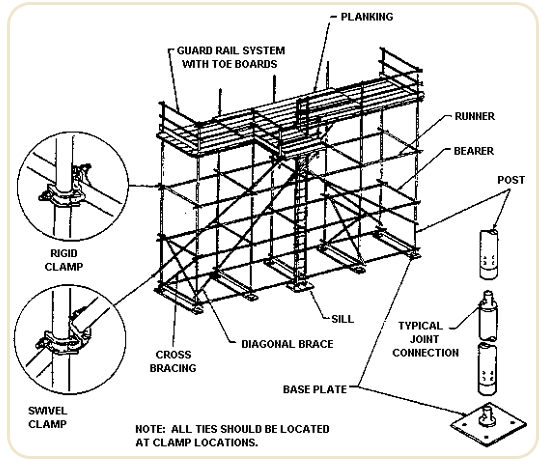The Benefits of Scaffolding for Safety And Security and Efficiency in Structure Projects
Scaffolding is a crucial part in the world of building, dramatically adding to both safety and operational efficiency. The effect of scaffolding extends beyond basic security actions; its critical application can change job timelines and end results (Scaffolding).
Boosted Employee Safety And Security

Boosted worker safety is a vital worry in the construction market, where the dangers connected with drops and accidents can have alarming effects. Efficient scaffolding systems play a crucial role in minimizing these risks by providing steady systems for workers at raised elevations. By guaranteeing that scaffolding is appropriately set up and preserved, building firms can significantly reduce the chance of drops, which are among the leading reasons of workplace injuries and deaths.
Additionally, scaffolding improves security via its design functions. Guardrails, toe boards, and non-slip surfaces add to a safe and secure workplace, lessening the threat of accidents. Furthermore, scaffolding enables workers to gain access to hard-to-reach areas without the need for makeshift services, which can endanger safety criteria.
Educating employees on the appropriate usage of scaffolding is similarly important. Making sure that personnel are well-informed concerning lots capacities, setting up treatments, and safety and security methods additionally improves the efficiency of scaffolding in avoiding accidents. In conclusion, including durable scaffolding systems within building projects not only boosts worker safety yet additionally promotes a culture of safety and security that benefits the entire labor force while enhancing overall performance.
Improved Accessibility and Movement

Moreover, scaffolding enables for the convenient transport of tools and products, decreasing downtime connected with moving equipment. Employees can effectively access numerous areas of a job, which is specifically important in intricate builds where vertical and straight activity is constant - Scaffolding. This availability not just streamlines operations but likewise allows teams to react quickly to changing task needs
Additionally, scaffolding can be tailored to suit specific website problems, boosting movement in tight or irregular areas. This adaptability makes certain that construction tasks can continue smoothly, despite the difficulties offered by the setting. By fostering enhanced gain access to and flexibility, scaffolding plays an important role in sustaining building crews and optimizing the general efficiency of structure projects.
Enhanced Job Efficiency
In construction, job performance is dramatically affected by the effective use scaffolding systems. By providing a steady and safe and secure platform for workers, scaffolding reduces downtime and accelerates the rate of building and construction activities. With enhanced access to raised workplace, groups her latest blog can finish jobs extra promptly, decreasing the overall project timeline.
The modular nature of modern-day scaffolding permits quick setting up and disassembly, allowing swift shifts in between different phases of a project. This flexibility not just improves workflow yet additionally adds to much better control among different trades, as numerous teams can function at the same time on various sections of a framework.
Additionally, scaffolding makes certain that workers are this website located correctly to execute their tasks without unneeded pressure or risk of injury, therefore lowering the likelihood of crashes that can lead to pricey delays. Enhanced precaution embedded in scaffolding systems, such as guardrails and toe boards, more support efficient operations by maintaining employee concentrate on the job available rather than safety and security problems.

Flexibility for Different Jobs
Scaffolding systems stand apart for their versatility across a large range of building and construction projects, with the ability of meeting particular website needs and jobs. Their modular design permits fast changes to accommodate different building types, from domestic to industrial structures, making certain that employees have risk-free gain access to at different elevations and angles.
These systems can be tailored for diverse applications, such as frontage job, interior restorations, or heavy-duty commercial projects. Lightweight aluminum scaffolds are perfect for indoor job, while robust steel frameworks offer the essential support for large-scale construction. The convenience of scaffolding reaches its capability to be set up for both permanent and momentary structures, allowing service providers to successfully prepare and implement their tasks.
In addition, scaffolding can be utilized in difficult settings, including metropolitan settings where space is minimal or on uneven surface where typical gain access to remedies are unwise. This versatility lessens the demand for several access services, minimizing prices and task timelines. By suiting a range of conditions and tasks, scaffolding boosts the overall performance and performance of building efforts, proving to be an essential possession in the building sector.
Conformity With Safety And Security Requirements
How can building and construction jobs make sure the safety and security of workers while maintaining effectiveness? Conformity with safety and security standards is paramount in accomplishing this equilibrium. Regulatory frameworks, such as OSHA in the United States, provide guidelines that regulate making use of scaffolding, guaranteeing that it satisfies stringent safety criteria. By adhering to these criteria, building and construction business can minimize the threat of crashes, which not only secures workers however also enhances overall task effectiveness.
Proper scaffolding layout and installation play a vital role in compliance. Educating workers on safe scaffold usage and the value of compliance with security requirements additionally enhances a culture of safety on-site.
Additionally, documents and record-keeping pertaining to safety assessments and employee training are vital. These practices not just show conformity but additionally offer accountability and transparency. Inevitably, by focusing on adherence to safety and security scaffolders yard requirements, building and construction projects can cultivate a safer workplace, thus raising productivity and performance without compromising worker safety and security.
Final Thought
In final thought, scaffolding offers as a crucial component in structure jobs, considerably enhancing safety and security and performance. Adherence to security requirements underscores the value of scaffolding in achieving successful task outcomes, making it essential in the building and construction industry.
Scaffolding is a necessary element in the realm of construction, substantially contributing to both security and functional effectiveness. The effect of scaffolding expands past fundamental security measures; its strategic implementation can change project timelines and outcomes. In verdict, integrating durable scaffolding systems within building and construction tasks not just enhances worker security yet additionally advertises a culture of security that benefits the entire workforce while boosting general performance.
In final thought, scaffolding serves as a crucial element in building projects, significantly enhancing safety and efficiency. Adherence to safety standards emphasizes the relevance of scaffolding in accomplishing effective project results, making it essential in the building market.